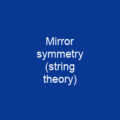What Makes Six So Special?
Six, that humble number following five and preceding seven, holds a unique place in mathematics and beyond. Is it just another number on the number line, or does six possess some hidden magic? Let’s dive into its fascinating properties.
The Number Six: A Mathematical Marvel
Is six just any old composite number, or is there more to it than meets the eye? Well, let’s explore. Six is not only the second smallest composite number but also a perfect number! This means that the sum of its proper divisors (1, 2, and 3) equals itself: 6 = 1 + 2 + 3. Isn’t that intriguing? It’s like finding a hidden treasure in the world of numbers!
The Six Exponentials Theorem and Beyond
Now, let’s venture into more complex territories. The six exponentials theorem is a deep result in transcendental number theory. It involves six exponentials, which might sound intimidating but is actually quite fascinating when you break it down. And then there’s the symmetric group S3, with its six elements—another layer of complexity wrapped around this simple number.
Shapes and Symmetry: Six in Geometry
But numbers aren’t just about abstract concepts; they also shape our world in tangible ways. Let’s look at some geometric wonders that involve the number six:
The Hexagon: A Shape of Six
A hexagon, with its six sides and angles, is a fascinating shape. Imagine a honeycomb, where bees use these perfect hexagons to build their homes. Each cell has six edges, making it incredibly efficient in terms of space usage. It’s like nature’s own solution to the problem of packing shapes together!
Cubes and Tetrahedrons: Six Faces and Edges
Now, think about a cube. It has six faces, each a perfect square. And if you look at a tetrahedron, it has six edges connecting its four triangular faces. These shapes are not just pretty; they have deep mathematical significance in geometry and beyond.
The Cultural Significance of Six
Numbers aren’t just about math; they also carry cultural weight. Let’s explore some interesting aspects:
Six in Language: Hexa and Sex-
In Greek and Latin, the prefix ‘hexa’ means six, appearing in words like hexadecimal (base-16 number system) and hexagon (six-sided polygon). The prefix ‘sex-‘ also means six, found in senary (base-6 numeral system), sexdactyly (having six fingers or toes), sextant (an instrument for measuring angles up to 90 degrees), and sexy prime pairs (prime numbers that differ by six).
The Evolution of the Digit Six
Now, let’s take a look at how the digit ‘6’ has evolved. The Hindu-Arabic numeral system traces its roots back to the Brahmi numerals of India. Over time, the shape of the digit changed significantly. The upper part became more curved while the lower part became straighter. Arabs dropped the lower part, and European evolution led us to our modern 6. On calculators, it’s written with six segments, resembling an inverted 9.
From Snowflakes to Coffins: Six in Everyday Life
Numbers aren’t just abstract; they’re woven into the fabric of our daily lives:
Snowflakes and Symmetry
Did you know that snowflakes have hexagonal symmetry due to ice’s crystal structure? Each flake is a masterpiece, with its six-sided perfection. It’s like nature’s own art gallery, where every piece is unique yet follows the same fundamental pattern.
The Six-Foot Rule
A coffin is buried six feet under the ground, and ‘six degrees’ means being connected by relationships. These phrases might seem mundane but carry deep meanings in their contexts. It’s like a secret code that we use without even realizing it!
Conclusion: The Ubiquity of Six
Six is more than just a number; it’s a gateway to understanding the world around us, from mathematical perfection to cultural significance and everyday life.

You want to know more about 6?
This page is based on the article 6 published in Wikipedia (retrieved on January 27, 2025) and was automatically summarized using artificial intelligence.






